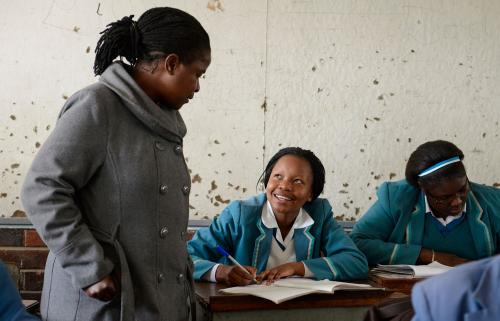This is one in a series of blog posts introducing the Center for Universal Education’s 2017 Echidna Global Scholars.
If you thought laws and policy would positively impact girls’ education in heavily patriarchal Maasai culture in Kenya, then you need to think again. In countries like Kenya, culture and traditions heavily impact girls’ ability to enroll and complete schooling and transition to college. To improve girls’ education we need to engage the custodians of tradition and culture: elders, community and spiritual leaders, elected leaders, youth, and warriors. They are the primary decisionmakers and wield the power, influence, and authority to control the quest for girls’ education.
Although the introduction of free primary school in Kenya in 2003 led to an increase in school attendance across the country, enrollment rates in marginalized areas remain much lower. Of those who enroll in the first year of school, barely one in five make it to their eighth year—with dropouts attributed to early marriage, female genital mutilation (FGM), poverty, and other factors. In Narok County, a predominantly Maasai area, only one in 15 girls enrolled in primary school proceeded to secondary school. Girls’ transition rates to university are even less common: 2.4 percent in Trans Mara West and 1 percent in Narok North. Despite a strong political commitment to education, access is still lopsided.
Maasai traditions play a big role in the education challenge; coupled with poverty, ignorance, and preference for boys, these factors all conspire to disadvantage girls’ education. In addition, there is a strong correlation between parents’ education status and mediating socio-cultural issues.
Where A Girl is Worth a Cow: The Economic Value of Girls in Maasai Culture
Maasai girls and women are never seen as permanent members of their families. Instead, they pass between households and clans when they are married. Marriage is an important part of Maasai culture and young women and men have little say in who they will marry. Early and forced marriages are still common in rural areas and bride wealth is a big deal. In the Maasai community, a girl is worth the value of a cow or two, a herd of sheep and goats, or both. In other words, girls often have little use except as a conduit to bring bride wealth to their families. Such practices have ensured that less than 20 percent of Maasai girls enroll in school, few finish primary school, and even less transition to secondary school and universities.
Female Genital Mutilation and Early Marriage
FGM, a long-standing socio-cultural practice deeply rooted in tradition, has a prevalence of nearly 89 percent throughout Maasailand. While FGM is outlawed in Kenya, a large number of parents still force their girls to undergo FGM to avoid teenage pregnancies and increase their marriageability. Typically, Maasai girls are circumcised between ages 11-13 and then soon married to a man chosen by her father in exchange for cattle. The consequences of FGM and early marriage on girls are grave. Evidence, together with my own findings from working with survivors of FGM, shows that not only does FGM harm girls personally, physically, and psychologically, it also heavily impacts economic development.
Girls who marry early are often forced to leave school and terminate their education. They will likely never return to school after marriage because of household chores, frequent pregnancies, child-rearing, and other restrictions. Besides, many pastoralists’ parents do not see the immediate benefits of an education. Consequently, many are not willing to wait for nearly 20 years to see returns on their education investments, when girls bring immediate returns in the form of dowry.

The Role of Community-led Solutions
Despite this problem, the Maasai have a rich socio-cultural and spiritual heritage that can be harnessed as a force for social good. Spiritual and community leaders are thought leaders and opinion shapers. They are likewise crucial voices in confronting FGM and early marriage, especially if they are engaged in the process with respect and cultural sensitivity. Respectable spiritual leaders can also build a concern for girls’ education into their sermons. We need such leaders to have these frank conversations with men and elders. They need to interrogate culture, traditions, and their impact on girls’ health and education. I strongly believe that by focusing on community-led solutions and leveraging the power of these critical stakeholders we can better ensure that Maasai girls have an access to education.
Already, there is progress: A local cricket team, the Maasai Cricket Warriors, is fighting against FGM by encouraging young men to say no to the practice. Such groups can be leveraged to build agency, concern, and action for girls’ education at the local and national levels.
Girls from all over the world hold the key to our most pressing challenges, including climate change and environmental sustainability. Studies suggest girls’ education significantly and positively impacts families and communities. Investing in girls’ education is imperative. It is this agency that has propelled me to create Let Maasai Girls Learn, an initiative to mobilize local and global action to enroll and keep Maasai girls in school.
As an Echidna Scholar, I am exploring innovative ways in which we can overcome educational barriers and rally action to let Maasai girls learn. To accomplish this, I seek to further engage with a diverse group of actors—the gate keepers of tradition, youth and women—through training and sustained dialogue. It is evident that there is a research gap in Maasai girls’ enrollment, dropout, and transition rates. This is important because the lives of millions of out-of-school Maasai girls depend on it. As a Maasai woman and passionate role model, I am working tirelessly to ensure the future and dignity of all Maasai girls.
The Brookings Institution is committed to quality, independence, and impact.
We are supported by a diverse array of funders. In line with our values and policies, each Brookings publication represents the sole views of its author(s).






Commentary
How girls’ education intersects with Maasai culture in Kenya
July 25, 2017